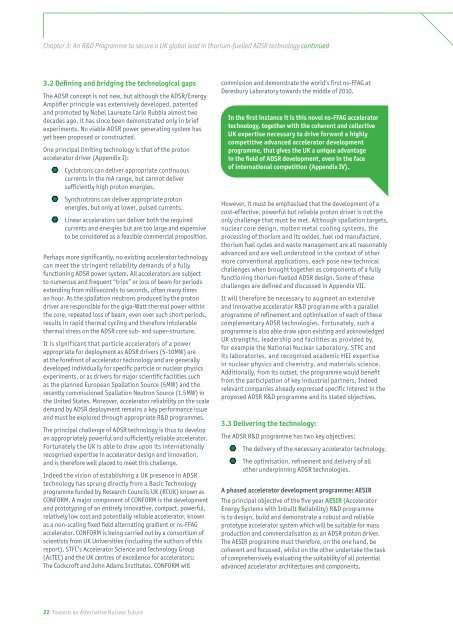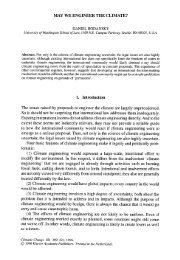ThorEA - Towards an Alternative Nuclear Future.pdf
ThorEA - Towards an Alternative Nuclear Future.pdf
ThorEA - Towards an Alternative Nuclear Future.pdf
Create successful ePaper yourself
Turn your PDF publications into a flip-book with our unique Google optimized e-Paper software.
Chapter 3: An R&D Programme to secure a UK global lead in thorium-fuelled ADSR technology continued<br />
3.2 Defining <strong>an</strong>d bridging the technological gaps<br />
The ADSR concept is not new, but although the ADSR/Energy<br />
Amplifier principle was extensively developed, patented<br />
<strong>an</strong>d promoted by Nobel Laureate Carlo Rubbia almost two<br />
decades ago, it has since been demonstrated only in brief<br />
experiments. No viable ADSR power generating system has<br />
yet been proposed or constructed.<br />
One principal limiting technology is that of the proton<br />
accelerator driver (Appendix I):<br />
Cyclotrons c<strong>an</strong> deliver appropriate continuous<br />
currents in the mA r<strong>an</strong>ge, but c<strong>an</strong>not deliver<br />
sufficiently high proton energies.<br />
Synchrotrons c<strong>an</strong> deliver appropriate proton<br />
energies, but only at lower, pulsed currents.<br />
Linear accelerators c<strong>an</strong> deliver both the required<br />
currents <strong>an</strong>d energies but are too large <strong>an</strong>d expensive<br />
to be considered as a feasible commercial proposition.<br />
Perhaps more signific<strong>an</strong>tly, no existing accelerator technology<br />
c<strong>an</strong> meet the stringent reliability dem<strong>an</strong>ds of a fully<br />
functioning ADSR power system. All accelerators are subject<br />
to numerous <strong>an</strong>d frequent “trips” or loss of beam for periods<br />
extending from milliseconds to seconds, often m<strong>an</strong>y times<br />
<strong>an</strong> hour. As the spallation neutrons produced by the proton<br />
driver are responsible for the giga-Watt thermal power within<br />
the core, repeated loss of beam, even over such short periods,<br />
results in rapid thermal cycling <strong>an</strong>d therefore intolerable<br />
thermal stress on the ADSR core sub- <strong>an</strong>d super-structure.<br />
It is signific<strong>an</strong>t that particle accelerators of a power<br />
appropriate for deployment as ADSR drivers (5-10MW) are<br />
at the forefront of accelerator technology <strong>an</strong>d are generally<br />
developed individually for specific particle or nuclear physics<br />
experiments, or as drivers for major scientific facilities such<br />
as the pl<strong>an</strong>ned Europe<strong>an</strong> Spallation Source (5MW) <strong>an</strong>d the<br />
recently commissioned Spallation Neutron Source (1.5MW) in<br />
the United States. Moreover, accelerator reliability on the scale<br />
dem<strong>an</strong>d by ADSR deployment remains a key perform<strong>an</strong>ce issue<br />
<strong>an</strong>d must be explored through appropriate R&D programmes.<br />
The principal challenge of ADSR technology is thus to develop<br />
<strong>an</strong> appropriately powerful <strong>an</strong>d sufficiently reliable accelerator.<br />
Fortunately the UK is able to draw upon its internationally<br />
recognised expertise in accelerator design <strong>an</strong>d innovation,<br />
<strong>an</strong>d is therefore well placed to meet this challenge.<br />
Indeed the vision of establishing a UK presence in ADSR<br />
technology has sprung directly from a Basic Technology<br />
programme funded by Research Councils UK (RCUK) known as<br />
CONFORM. A major component of CONFORM is the development<br />
<strong>an</strong>d prototyping of <strong>an</strong> entirely innovative, compact, powerful,<br />
relatively low cost <strong>an</strong>d potentially reliable accelerator, known<br />
as a non-scaling fixed field alternating gradient or ns-FFAG<br />
accelerator. CONFORM is being carried out by a consortium of<br />
scientists from UK Universities (including the authors of this<br />
report), STFC’s Accelerator Science <strong>an</strong>d Technology Group<br />
(AsTEC) <strong>an</strong>d the UK centres of excellence for accelerators:<br />
The Cockcroft <strong>an</strong>d John Adams Institutes. CONFORM will<br />
22 <strong>Towards</strong> <strong>an</strong> <strong>Alternative</strong> <strong>Nuclear</strong> <strong>Future</strong><br />
commission <strong>an</strong>d demonstrate the world’s first ns-FFAG at<br />
Daresbury Laboratory towards the middle of 2010.<br />
In the first inst<strong>an</strong>ce it is this novel ns-FFAG accelerator<br />
technology, together with the coherent <strong>an</strong>d collective<br />
UK expertise necessary to drive forward a highly<br />
competitive adv<strong>an</strong>ced accelerator development<br />
programme, that gives the UK a unique adv<strong>an</strong>tage<br />
in the field of ADSR development, even in the face<br />
of international competition (Appendix IV).<br />
However, it must be emphasised that the development of a<br />
cost-effective, powerful but reliable proton driver is not the<br />
only challenge that must be met. Although spallation targets,<br />
nuclear core design, molten metal cooling systems, the<br />
processing of thorium <strong>an</strong>d its oxides, fuel rod m<strong>an</strong>ufacture,<br />
thorium fuel cycles <strong>an</strong>d waste m<strong>an</strong>agement are all reasonably<br />
adv<strong>an</strong>ced <strong>an</strong>d are well understood in the context of other<br />
more conventional applications, each pose new technical<br />
challenges when brought together as components of a fully<br />
functioning thorium-fuelled ADSR design. Some of these<br />
challenges are defined <strong>an</strong>d discussed in Appendix VII.<br />
It will therefore be necessary to augment <strong>an</strong> extensive<br />
<strong>an</strong>d innovative accelerator R&D programme with a parallel<br />
programme of refinement <strong>an</strong>d optimisation of each of these<br />
complementary ADSR technologies. Fortunately, such a<br />
programme is also able draw upon existing <strong>an</strong>d acknowledged<br />
UK strengths, leadership <strong>an</strong>d facilities as provided by,<br />
for example the National <strong>Nuclear</strong> Laboratory, STFC <strong>an</strong>d<br />
its laboratories, <strong>an</strong>d recognised academic HEI expertise<br />
in nuclear physics <strong>an</strong>d chemistry, <strong>an</strong>d materials science.<br />
Additionally, from its outset, the programme would benefit<br />
from the participation of key industrial partners. Indeed<br />
relev<strong>an</strong>t comp<strong>an</strong>ies already expressed specific interest in the<br />
proposed ADSR R&D programme <strong>an</strong>d its stated objectives.<br />
3.3 Delivering the technology:<br />
The ADSR R&D programme has two key objectives:<br />
The delivery of the necessary accelerator technology,<br />
The optimisation, refinement <strong>an</strong>d delivery of all<br />
other underpinning ADSR technologies.<br />
A phased accelerator development programme: AESIR<br />
The principal objective of the five year AESIR (Accelerator<br />
Energy Systems with Inbuilt Reliability) R&D programme<br />
is to design, build <strong>an</strong>d demonstrate a robust <strong>an</strong>d reliable<br />
prototype accelerator system which will be suitable for mass<br />
production <strong>an</strong>d commercialisation as <strong>an</strong> ADSR proton driver.<br />
The AESIR programme must therefore, on the one h<strong>an</strong>d, be<br />
coherent <strong>an</strong>d focussed, whilst on the other undertake the task<br />
of comprehensively evaluating the suitability of all potential<br />
adv<strong>an</strong>ced accelerator architectures <strong>an</strong>d components.



